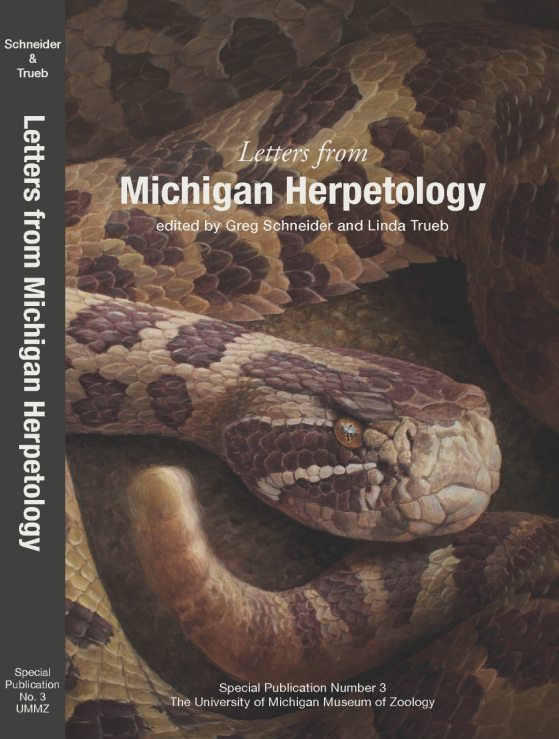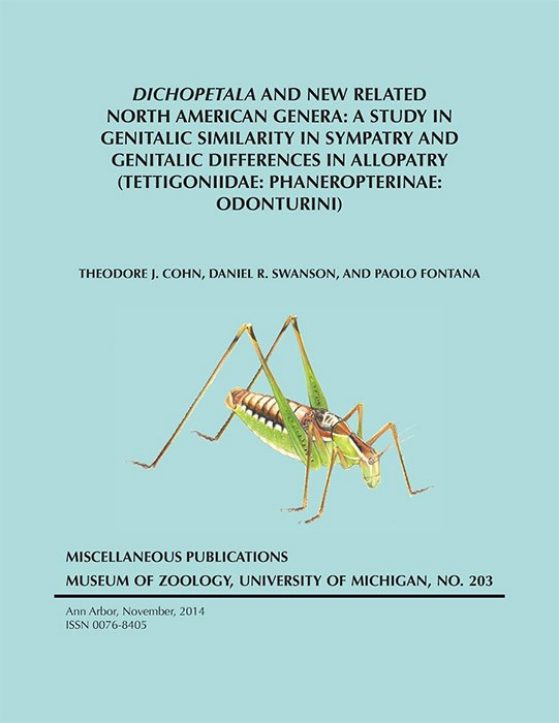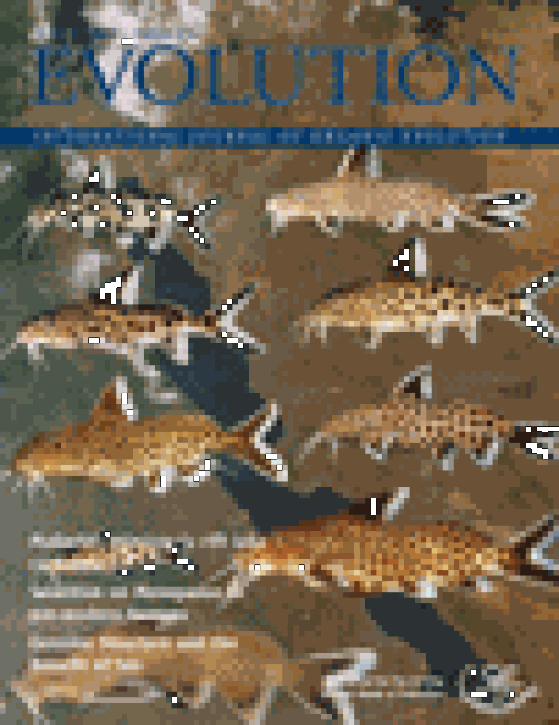 Letters from Michigan Herpetology
Letters from Michigan Herpetology
Schneider, Greg; Trueb, Linda, 2021
Special Publication Number 3 of the Museum of Zoology. Order Now
 Dichopetala and new Related North American Genera
Dichopetala and new Related North American Genera
T. J. Cohn (posthumous), D.R. Swanson, and P. Fontana, 1/7/2014
The genus Dichopetala Brunner von Wattenwyl, 1878 sensu Rehn and Hebard, 1914 is revised, with the description of 6 new genera and 14 new species.
 The Natural History of the Ants of Michigan's E.S. George Reserve
The Natural History of the Ants of Michigan's E.S. George Reserve
Mary Talbot, 12/1/2012
In 1951 Mary Talbot began a 26 year research project to study and document the populations of ants in the Edwin S, George Reserve. This is the culmination of that effort.
 Fishes of the Greater Mekong Ecosystem (Miscellaneous Publication 201)
Fishes of the Greater Mekong Ecosystem (Miscellaneous Publication 201)
Walter J. Rainboth, Chavalit Vidthayanon, and Mai Dinh Yen, 6/1/2012
llustrating all 2541 species known to occur in the Greater Mekong Ecosystem "Fishes of the Greater Mekong Ecosystem" is a valuable resource for biologists across multiple disciplines including systematics, taxonomy, ecology, biogeography, conservation, and fisheries. View details and download order form.
 Mating mites trapped in amber reveal sex role reversal
Mating mites trapped in amber reveal sex role reversal
Pavel Klimov, 3/1/2011
In a paper published March 1, 2011 in the Biological Journal of the Linnean Society, researchers Pavel Klimov and Ekaterina Sidorchuk describe an extinct mite species in which the traditional sex roles were reversed.
 Slow snails, fast genes: Predatory snails refine venoms through continuous gene duplication
Slow snails, fast genes: Predatory snails refine venoms through continuous gene duplication
Dan Chang and Thomas Duda, 2/15/2012
Dan Chang & Thomas Duda, two University of Michigan evolutionary biologists report that their reconstruction of the evolutionary history of these genes has revealed rapid and continuous gene duplication over the last 11 million years that is coupled with the accelerated rates of conotoxin evolution.
 The uncharacterized gene 1700093K21Rik and flanking regions are correlated with reproductive isolation in the house mouse, Mus musculus
The uncharacterized gene 1700093K21Rik and flanking regions are correlated with reproductive isolation in the house mouse, Mus musculus
D. H. Kass, V. Janousek, L. Wang, and P. K. Tucker, 2/19/2014
 Sperm related phenotypes implicated in both maintenance and breakdown of a natural species barrier in the house mouse.
Sperm related phenotypes implicated in both maintenance and breakdown of a natural species barrier in the house mouse.
J. Albrechtová, T. Albrecht, S. Baird, M. Macholán, P. Munclinger, G. Rudolfsen, P. K. Tucker, and J. Piálek, 10/10/2012
 Drivers of marine biodiversity: Tiny, freeloading clams find the key to evolutionary success
Drivers of marine biodiversity: Tiny, freeloading clams find the key to evolutionary success
Jingchun Li, Diarmaid Ofoighil, 8/8/2012
What mechanisms control the generation and maintenance of biological diversity on the planet? EEB graduate student, Jingchun Li, first author of the PLoS ONE paper and her advisor, Professor Diarmaid Ó Foighil, studied this question using tiny ocean clams.
 Conservative coevolution of Müllerian mimicry in Rift Lake catfish
Conservative coevolution of Müllerian mimicry in Rift Lake catfish
Jeremy Wright, 2/1/2011
Ancestral state reconstructions and statistical comparisons of color pattern divergence in Tanganyikan Synodontis indicate that Müllerian mimicry in these catfish has developed through diversification of an aposematic common ancestor with subsequent conservative mutualistic coevolution among its daughter lineages.
 The endothelial-cell specific regulatory mutation, Mvwf1, is a common murine founder allele.
The endothelial-cell specific regulatory mutation, Mvwf1, is a common murine founder allele.
J. M. Johnson, G. G. Levy, R. J. Westrick, P. K. Tucker and D. Ginsburg, 1/19/2008

